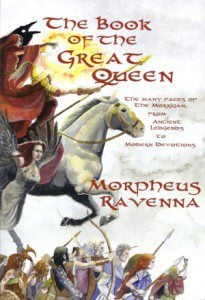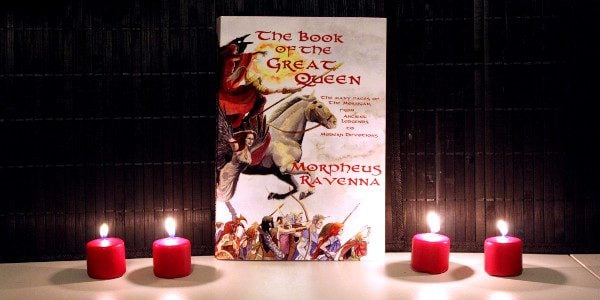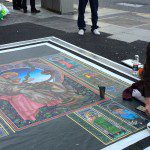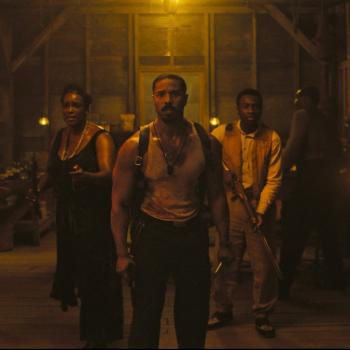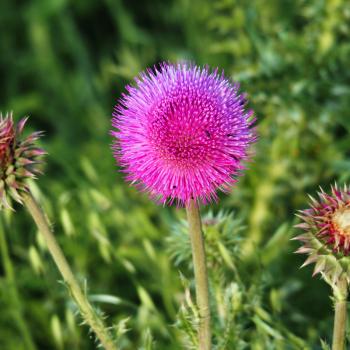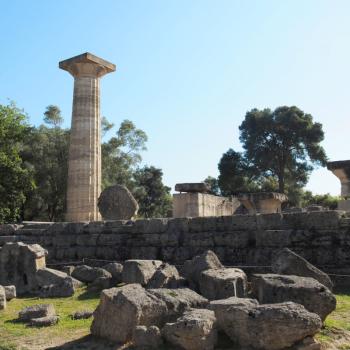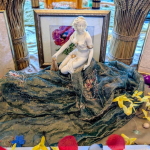by Morpheus Ravenna
published by Concrescent Press, May 2015
trade paperback: $29.99
484 pages
Today I bring you three reviews of The Book of the Great Queen: very short, short, and detailed.
We’ll start with the very short review: if you have any interest in the Morrígan, or if you have any interest in Celtic history and culture, read this book.
And now the short review, taken from one of the back cover quotes:
The Book of the Great Queen is an extensive analysis of the literary, historical, and archeological records of the Morrígan and the Celtic societies in which She was first worshipped. But it’s more than a work of scholarship – it’s a guide to encountering and experiencing the Great Queen for yourself. The individual and group practices Morpheus Ravenna describes are a blueprint for the restoration of devotional polytheism in the contemporary world.
John Beckett – Druid and blogger, “Under the Ancient Oaks”
Still with me? Here’s the detailed review.
I always mention how I get the books I review. I don’t review books differently based on whether I buy them or if I get review copies, but I like to make full disclosure and you can decide if that’s important to you or not.
I didn’t just buy the Book of the Great Queen, I bought into it. I supported the IndieGogo campaign and I encouraged others to support it as well. I bought into it because I believe in the Morrígan – not just in Her existence, but also in Her work in this world. And I believe in Morpheus Ravenna. So do a lot of other people – the crowdfunding campaign was an overwhelming success.
I had high expectations. The Book of the Great Queen exceeds them.
The first part of the book is an exhaustive analysis of the literary and mythological appearances of the Morrígan. I’m a Druid and a Celtophile – I’ve read a lot of these stories. But some of them I haven’t been able to find, and some of them I hadn’t even heard of. Each one has a summary that focuses on what it tells us about the Morrígan and the many ways She was understood by the people who told these stories. Then the various Goddesses – or possibly, various names for one Goddess – are examined in depth.
Perhaps the most helpful chapter is “One, Three, and Many” which explores the multiple nature of the Morrígan.
Who is the Morrígan? Many names are associated with the Morrígan: Badb, Macha, Anu, Danu, Némain, Fea, and Bé Néit. Are they all aspects of one divinity, or separate, independent sister Goddesses? Is the Morrígan a single, triple, or multiple Goddess? Who are the Morrígna and what does this collective term mean?

As you might expect, the answer is complicated. Morpheus says “this question has been approached differently by people throughout history.” She identifies four patterns in the lore, but even those do not lead to a definitive answer. What is clear is that the modern Pagan “Maiden, Mother, and Crone” conception does not fit the Morrígan at all.
I usually speak of Morrígan in the singular because that’s how I’ve experienced Her. But I’m learning that there are other deities – be they aspects or separate beings – I need to become acquainted with. The true nature of the Gods remains a mystery.
The second part looks at how and where the Morrígan was worshipped. Individual chapters examine the land and features on the land (including temples – yes, the Celts had them, at least a few), iconography, sacrifice, priesthood, oracles and divination, sorcery, and Her worship in relation to warriors and battle.
Each section begins with the relevant history and ends with “Living Practice” – how devotees and priests of the Morrígan are honoring, worshipping, and communing with Her today. But a deep, robust Celtic and polytheist practice involves more than the worship of one Goddess, even the Great Queen. The section “The Sovereignty of Spirits” makes a key point that often gets overlooked in some Pagan traditions:
Polytheism, as a religious practice of relationship, can only begin when we recognize and honor the agency and sovereignty of spiritual beings. Their lives and life force are not ours to command; their homes, landscapes, gateways, contexts, and histories are not there for our pleasure or even for our teaching. They live in the world as we do, existing for their own purposes, pursuing their own destinies, in sovereign relationship to their landscapes and contexts.
The section on devotion is particularly helpful – 14 pages of things you can do to build a meaningful spiritual practice. I do most of these – some daily, others periodically – and I can attest to their effectiveness. The section on priesthood draws clear differences between the role and commitment of a priest and that of a non-priestly devotee, and it points out that priesthood is a path of service.
The chapters “Battle Cultus” and “The Warrior’s Initiation” answer the question of why people who love peace would worship a Battle Goddess. The answer is complicated but can be summarized in one quote: “battle is sovereignty in action.” Even those of us who love peace must sometimes fight, or else be overrun by those who would oppress or destroy us.
The book ends with a statement I think is very important as we consider a Pagan and polytheist worldview in contrast to the monotheist worldview that still dominates our culture.
The reading and study of lore can only take you so far, and no further. It is up to you now to take what you may have found of value in this book and bring it to life in your own practice.
The lore of the Morrígan is complicated and ambiguous and it does not fit neatly into a simple dualistic narrative. We have two choices as to how to deal with this lack of clarity and certainty.
We can examine the texts and declare some canon and others heresy. We can create elaborate doctrines to justify our choices. We can use coercion and outright violence to silence those who disagree with us. We can create the One True Way… as followers of other religions have done many times.
Or, we can take the lore for what it is – the stories of men and women and the experiences they had in a particular place and time. We can embrace the ambiguity and let it remind us to remain humble about what we do and do not know. We can learn from skilled priests and then develop our own spiritual practices. We can stop worrying about thinking and believing the right things and start doing the right things.
We live in tumultuous times. It is no surprise that the Morrígan is especially active now.
I have often felt, and have heard others say too, that the Morrígan is a fitting Goddess for our times. She holds and teaches the powers and wisdoms we need to be able to face these choices. She sees those who are born on this battlefield. She sees what can rise in us to meet the battle, and calls that forth from within us. We need strengths like these. We need the heroic ethos. We need whatever it is that can grant us the courage to be a force for justice and right action.
The Morrígan is a fitting Goddess for our times, and The Book of the Great Queen is the most complete and thorough guide yet written to learning about Her, honoring Her, and taking up Her great work.


